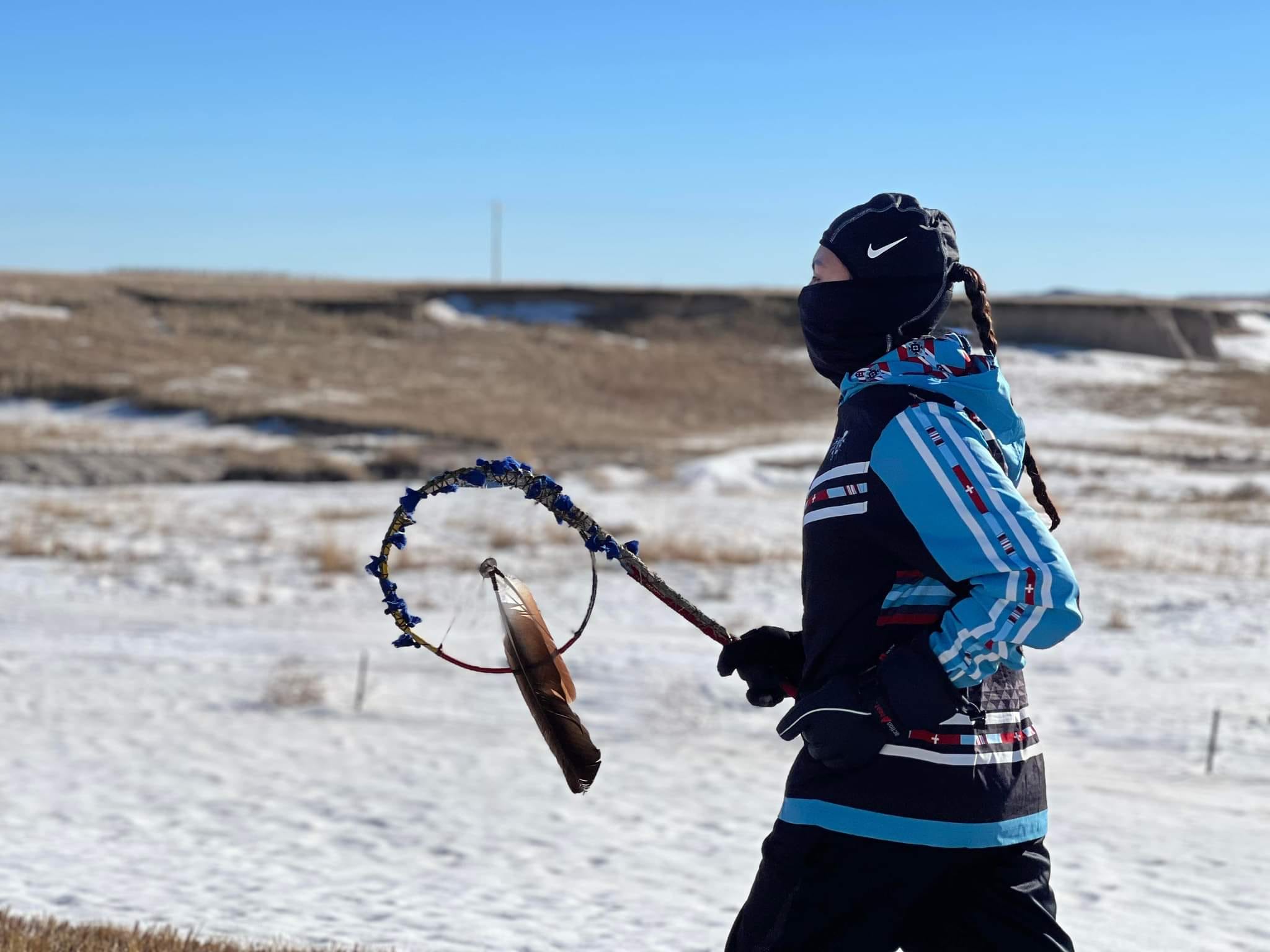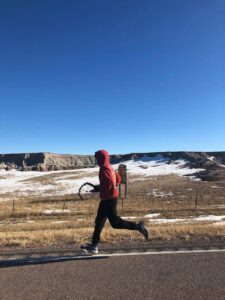Takini: The Wounded Knee Survivors Run

December 15, 1890 Sitting Bull was killed by Tribal Police, who were directed by the Agency Superintendent James McLaughlin to arrest Sitting Bull. Sitting Bull Tiwahe and close Mnicoujou Tiwahe shared within their families, that there was never an intention to arrest Sitting Bull but to eliminate Sitting Bull because he resisted the assimilation the US government was forcing on the Lakota people.
Over 200 of Sitting Bulls family members fled south to the Cheyenne River Agency from the Standing Rock Agency. All but 40 Hunkpapa were talked into turning themselves into the Agency Superintendent at the Cheyenne River Agency. Hunkpapa relatives came to Spotted Elks Mnicoujou camp.
It was during this time, Chief Spotted Elk along with 600 Mnicoujou families and 40 Hunkpapa Sitting Bull family members traveled to the Pine Ridge Agency to seek counsel with Chief Red Cloud. They were intercepted by scouts and US Army Forces on December 28, 1890 and forced to camp on the Wounded Knee creek located on the Pine Ridge Agency.
On the morning of December 29, 1890, our Mnicoujou and Hunkpapa families were massacred, the majority of the people massacred were women, children and elders. Chief Spotted Elk was among the dead after the massacre. The massacre was committed by US Army Forces, among the army regiments that were present at the Wounded Knee creek was the 7th Cavalry.
 Today the US Army still flies it floaters recognizing the Massacre as a Battle, which was not a battle when a peaceful camp flying the white flag of truce was attacked and unspeakable acts of brutality were committed against our people. Our people fled on foot, running from the onslaught.
Today the US Army still flies it floaters recognizing the Massacre as a Battle, which was not a battle when a peaceful camp flying the white flag of truce was attacked and unspeakable acts of brutality were committed against our people. Our people fled on foot, running from the onslaught.
There are many stories from families that had shared their ancestor’s accounts. Stories of young warriors 13 to 15 years of age riding horses in an out of the massacre, gathering as many children as they could to ride them to safety and then ride back into the fray. Those warriors were never seen again, died trying to save the lives of children.
The few that were able to get away had to travel at night, traveling during the day was too dangerous due to the militia and army still pursuing them. Many died during their journey back to Cheyenne River, due to wounds, starvation, and the inclement weather.
The ones that did survive the trek, shared stories of sleeping in bushes, areas where the rabbits sleep. They couldn’t make fires because they were still being hunted so the children would huddle together to keep warm and the food, when they did eat they ate raw, no fires could be made.
My Leksi Ben Elk Eagle shared a story. He said that when he was a little boy, they used to travel to the mass gravesite and camp for a couple of weeks, to clean the area and spend time with other relatives that were descendants of the massacre. My Leksi was told that for two years, bodies were found along the path back towards Cheyenne River.
We began The Wounded Knee Survivors Run on Dec 2012, this year is our 10th Annual. When we first started the run not many people understood why we were doing the run, but in time people started to hear and see us.
Marlin and Glorianna Under Baggage who live along Red Water creek started to come to greet us, bringing pejuta to help our runners in the cold, to make them strong. We began to gather at Potato Creek, Marlin told stories of the children who ran from the massacre, the stories of them crying in the night, from hunger and pain, some wounded and dying all while they were freezing from the weather, no shoes on or warm clothes to keep them alive.
Some too young to survive the obstacles they were facing. Marlin pointed out a ridge to the south of where we stood, along this ridge they buried children and elders who died near the Potato Creek. The people in the area tried to help them but most died. Mr. Under Baggage is also a descendant of a Wounded Knee survivor.
Every year, elders come to us and share knowledge passed on through their families. This knowledge is important to our efforts to bring awareness and educate the world.
Our run begins on the morning of the Massacre, Dec 29 and we run throughout the day, usually until we are close to the Badlands. We begin preparation for the run days in advance, beginning with an Inipi ceremony. We make medicines to help us on the journey, prayer ties to carry along the run.
During the run we stop at certain places and spend time with relatives, these elders share knowledge with us and prayer. At the end of the first night, we attend another ceremony for the runners, we pray for affected families for continued healing, for resiliency of our nation.
We’ve lost relatives that were with us in the beginning of this run, we remember them and pray for their families as well. We are Lakota so this is important for us to support them, to help them heal.
The second day, we begin where we left off the night before, we run through the Badlands, leading north, following the back roads toward the Cheyenne River Sioux Tribe Reservation. Each night we usually run from morning until around 10 p.m. at night. The second night of the run, we finish at the old bridge located on the most southwestern part of CRST Reservation.
For now, we end our run here, until we can build something much more suitable for the event. After the run is completed the runners that can attend are invited to participate in the Inipi (sweat lodge) ceremony to complete the run. When we do things in prayer, we become a part of a living ceremony, that is why it’s important to do this in prayer and in a good way.
In the future we plan on creating a foundation for the Wounded Knee Survivors Run, to create memorials along the way back to CRST from Wounded Knee. To tell the story of the families and what they had gone through during this era. Our ancestors suffered atrocities so our nation could live the best life possible. We can’t let down our ancestors because they have expectations of us as well. I want to recognize our runners, some as young as age 8 ran this year, some of those young ones were newborn on this run years back and now they are carrying the staff and prayers.
Sophie Brings Plenty, January Lee, King Lee, Rowdy Bobtail Bear, Julissa Fillmore-Melendez, Joette Lee, Belle Brings Plenty, Joni Brings Plenty, Brett Brings Plenty, Seth Brings Plenty, Gabe Black Moon, Collin Dubray, Caden Benson, Austin Sanchez, Lucas Deters, Derek Eagle, Adyn Moran, Rhianna Little Bull, Taliyah Marshall, Wyatt Brings Plenty, Charles Red Bird/Kuntz, Eugene Arcoren, Almona Kills In Sight, Zaniya Iron Eyes, Shania Dreaming Bear.
Hau Pilamiya Mitakuye Oyasin, Joseph Brings Plenty Sr.
The post Takini: The Wounded Knee Survivors Run first appeared on Native Sun News Today.
